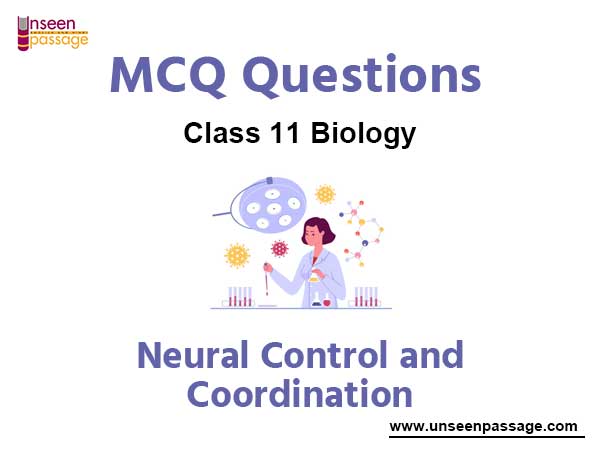Neural Control and Coordination MCQ Class 11 Biology
Please refer to Chapter 21 Neural Control and Coordination MCQ Class 11 Biology with answers below. These multiple-choice questions have been prepared based on the latest NCERT book for Class 11 Biology. Students should refer to MCQ Questions for Class 11 Biology with Answers to score more marks in Grade 11 Biology exams. Students should read the chapter Neural Control and Coordination MCQ Class 11 Biology and then attempt the following objective questions.
MCQ Questions Class 11 Biology Chapter 21 Neural Control and Coordination
The Neural Control and Coordination MCQ Class 11 Biology provided below covers all important topics given in this chapter. These MCQs will help you to properly prepare for exams.
Question. Read the following statements (A-D):
A. Hypothalamus controls body temperature, eating and drinking.
B. The midbrain receives and integrates visual, tactile and auditory inputs.
C. The medulla contains centres, which control respiration, cardiovascular reflexes and gastric secretions.
D. The entire process of voluntary response to a peripheral nerve stimulation is called reflex action.
Which of the following statement is in correct?
(a) C
(b) D
(c) B
(d) A
Answer
B
Question. The hormone which helps in the maintenance of electrolytes is-
(a) Aldosterone
(b) Androgenic steroids
(c) Melatonin
(d) Adrenaline
Answer
A
Question. Which of the following is not an endocrine gland?
(a) Hypothalamus
(b) Salivary gland
(c) Pituitary gland
(d) Pineal
Answer
B
Question. The axon terminals of a neuron contains
(a) Vesicles filled with neurotransmitters
(b) Vesicles filled with calcium ions
(c) Nissl’s granules
(d) Vesicles filled with hormones
Answer
A
Question. Reflex action is controlled by:
(a) Sympathetic nervous system
(b) Autonomous nervous system
(c) Spinal cord
(d) Peripheral nervous system
Answer
C
Question. Select the part of nervous system which transmit impulses from cerebrum to gastrocnemius muscle of body ?
(a) Sympathetic neural system
(b) Parasympathetic neural system
(c) Somatic neural system
(d) Basal cortex of brain
Answer
C
Question. Gray matter gives the greyish appearence due to highly concentrated :
(a) Axon
(b) Myelin sheath
(c) Cell bodies
(d) Dendron
Answer
C
Question. The photosensitive compounds (Photopigments) in the human eyes are composed of opsin (a protein ) and retinal this retinal is formed by :
(a) an aldehyde of vitamin -A
(b) a ketone of vitamin -A
(c) an aldehyde of vitamin -D
(d) a ketone of vitamin -D
Answer
A
Question. When the sensation for white light is produced?
(a) By various combination of cones & their photopigment
(b) When the cones are stimulated equally
(c) When the cones are stimulated unequally
(d) By various combination of rods and their photopigments
Answer
B
Question. In an accident, a person’s brain was injured due to which body temperature, hunger and water balance are not being regulated. Which one of the following parts of his brain is affected ?
(a) Medulla oblongata
(b) Cerebellum
(c) Hypothalamus
(d) Corpora quadrigemina
Answer
C
Question. Motor areas, sensory areas and large regions called as association areas are present in :
(A) Cerebral cortex
(B) White matter
(C) Inner part of cerebral hemisphere
(D) Gray matter
(a) B and C
(b) A and C
(c) A and B
(d) A and D
Answer
D
Question. The specific receptors of the vestibular apparatus responsible for maintenance of balance of body & posture are
(A) Organ of corti
(B) Crista
(C) Macula
(D) Cochlea
(a) A and D
(b) B and C
(c) A and C
(d) C and D
Answer
B
Question. Which one of the following statements are correct?
(i) Impulse transmission through electrical synapse is slow than a chemical synapse
(ii) Unmyelinated nerve fibres are commonly found in ANS and somatic neural systems.
(iii) Multipolar neurons are specially found in cerebral cortex.
(iv) Neural organisation is very simple in human beings.
(a) (i) and (ii)
(b) (ii) and (iv)
(c) (i) and (iii)
(d) (ii) and (iii)
Answer
D

